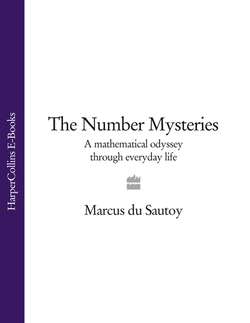Читать книгу The Number Mysteries: A Mathematical Odyssey through Everyday Life - Marcus Sautoy du - Страница 12
Why do science fiction writers like primes?
ОглавлениеWhen science fiction writers want to get their aliens to communicate with Earth, they have a problem. Do they assume that their aliens are really clever and have picked up the local language, or that they’ve invented some clever Babelfish-style translator that does the interpreting for them? Or do they just assume that everyone in the universe speaks English?
One solution that a number of authors have gone for is that mathematics is the only truly universal language, and the first words that anyone should speak in this language are its building blocks—the primes. In Carl Sagan’s novel Contact, Ellie Arroway, who works for SETI, the Search for Extra-Terrestrial Intelligence, picks up a signal which she realizes is not just background noise but a series of pulses. She guesses that they are binary representations of numbers. As she converts them into decimal, she suddenly spots a pattern: 59, 61, 67, 71 … all prime numbers. Sure enough, as the signal continues, it cycles through all the primes up to 907. This can’t be random, she concludes. Someone is saying hello.
Many mathematicians believe that even if there is a different biology, a different chemistry, even a different physics on the other side of the universe, the mathematics will be the same. Anyone sitting on a planet orbiting Vega reading a maths book about primes will still consider 59 and 61 to be prime numbers because, as the famous Cambridge mathematician G.H. Hardy put it, these numbers are prime ‘not because we think so, or because our minds are shaped in one way rather than another, but because it is so, because mathematical reality is built that way’.
The primes may be numbers that are shared across the universe, but it is still interesting to wonder whether stories similar to those I’ve related are being told on other worlds. The way we have studied these numbers over the millennia has led us to discover important truths about them. And at each step on the way to discovering these truths we can see the mark of a particular cultural perspective, the mathematical motifs of that period in history. Could other cultures across the universe have developed different perspectives, giving them access to theorems we have yet to discover?
Carl Sagan wasn’t the first and won’t be the last to suggest using the primes as a way of communicating. Prime numbers have even been used by NASA in their attempts to make contact with extra-terrestrial intelligence. In 1974 the Arecibo radio telescope in Puerto Rico broadcast a message towards the globular star cluster M13, chosen for its huge number of stars so as to increase the chance that the message might fall on intelligent ears.
The message consisted of a series of 0s and 1s which could be arranged to form a black and white pixelated picture. The reconstructed image depicted the numbers from 1 to 10 in binary, a sketch of the structure of DNA, a representation of our solar system and a picture of the Arecibo radio telescope itself. Considering that there were only 1,679 pixels, the picture is not very detailed. But the choice of 1,679 was deliberate because it contained the clue to setting out the pixels. 1,679=23×73, so there are only two ways to arrange the pixels in a rectangle to make up the picture. 23 rows of 73 columns produces a jumbled mess, but arrange them the other way as 73 rows of 23 columns and you get the result shown right. The star cluster M13 is 25,000 light years away, so we’re still waiting for a reply. Don’t expect a response for another 50,000 years!
FIGURE 1.05 The message broadcast by the Arecibo telescope towards the star cluster M13.
Although the primes are universal, the way we write them has varied greatly throughout the history of mathematics, and is very culture-specific—as our whistle-stop tour of the planet will now illustrate.
